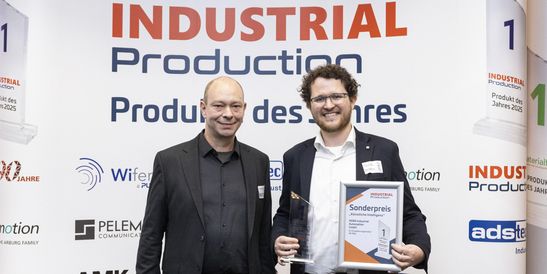How KEBA is bringing artificial intelligence to the industry
- AI
- 13.12.2023
- Reading Time: {{readingTime}} min
- Share Article

Contents
To answer these questions, we spoke to Stefan Fischereder, Product Manager Industrial AI at KEBA. In recent years, the company has increasingly focused on the topic of artificial intelligence and will be launching its own product for this purpose. This AI Extension Module is an addon to KEBA's existing control system. The module can be used to run AI models on industrial controllers without the need for a cloud connection.
KEBA has launched an Early Access Program (EAP) to further improve the AI Extension Module until it is ready for series production and to adapt it to the needs of companies. The EAP is a kind of test phase in which selected customers can try out the AI module and provide feedback.

How did the idea for the AI Extension Module come about?
Stefan Fischereder: The idea for the AI Extension Module comes from the fact that although there is a great need for AI applications in industry, there are also many hurdles that make successful implementation difficult. For example, many systems or machines are not connected to the internet. This prevents the use of cloud-based AI services. Or there are concerns about data security and data protection, which rule out data transfer to external providers. We therefore wanted to create a product that overcomes these hurdles and makes artificial intelligence accessible to industry.
How exactly does the AI extension module work?
Stefan Fischereder: The module is an addition to KEBA's existing control system. It extends an industrial control system with the ability to execute AI models directly on site in real time. You can think of the module as accelerator hardware in a consumer computer. It is reduced to the essential performance required to calculate neural networks. Without the graphics card part, which is primarily designed for games, but with a special architecture designed for calculating neural networks.
In addition, we are currently starting to build a software stack that will enable customers to access these capabilities from the PLC programming languages, for example. This will be particularly interesting if there are no AI experts available to program these capabilities. After all, expertise in automation does not automatically mean expertise in artificial intelligence. Both the AI Extension Module and the software stack are independent of the cloud and can be used in combination with any industrial control from KEBA. However, if customers prefer, it is also possible to combine the local functionalities with cloud solutions.
What are the advantages of the module?
Stefan Fischereder: Firstly, AI solutions can be implemented directly on the system without the need for an internet connection or an external platform. This increases security and flexibility. Secondly, this solution can be individually adapted to requirements without having to rely on ready-made models or services. This increases quality and efficiency. The AI solution can also be easily integrated into an existing system. No complex programming or installation is required. This increases user-friendliness and speed.

The AI module will be an integral part of an AI ecosystem from KEBA
You mentioned that KEBA has launched an Early Access Program (EAP) for the module. What do you mean by that?
Stefan Fischereder: Our AI Extension Module is currently available as a development kit. As part of the Early Access Program, we identify suitable companies that want to use our module on their machines before it goes into series production. On the one hand, they need the necessary know-how and the right use case. On the other hand, they should be willing to work with us on their problem. We accompany them during the test.
In which AI applications is the module used? Are these the expected ones or have companies surprised you?
Stefan Fischereder: The module is primarily used in artificial intelligence applications that involve computer vision. These are tasks that can be solved with classic algorithms, but are much more complex than with the use of artificial intelligence. In future, many companies not only want to be able to recognize objects within their automation systems, but also to derive process-relevant information based on their position, location or speed. This could be in production, for example, during quality control, sorting or packaging. We want to build up our expertise in these tasks and provide the AI engineering competence to be an ideal partner for our customers.

We have also had good experience with grasping point calculations for robots. This means that the AI Extension Module can be used to determine the optimum gripping point for a robot arm from an image of an object. This enables flexible and efficient handling of different objects without the need for complex programming.
However, there have also been interesting inquiries from the area of "pre-safety". In one case, the aim was to prevent safety devices from being triggered unintentionally. This has the potential to minimize unnecessary machine downtime. This is where object recognition or pose estimation offers an opportunity. Pose estimation refers to an object detection class. This means that people can be warned as soon as they approach a safety device. Of course, this also applies if they approach too quickly or enter the danger zone. The use case described is so exciting because it does not actually have anything to do with safety, but takes effect before that.
What are the next steps for the AI module and what are the plans for the future?
Stefan Fischereder: The next steps for the AI Extension Module are to continue the Early Access Program and make the development kits available to other companies. We want to prioritize and focus on the use cases in order to achieve the greatest potential for the companies.
At the same time, we are working on preparing the module for series production and evaluating different performance classes. This will allow us to address a wide range of problems and industry needs. We will also improve and expand the AI module's software environment to enable more applications of artificial intelligence, such as predictive quality or predictive maintenance. The AI module will be an integral part of an AI ecosystem from KEBA that extends and simplifies our Kemro X automation kit with artificial intelligence capabilities. We are also considering realizing different hardware constellations for the module in order to meet different performance and flexibility requirements.
Interview partner


























